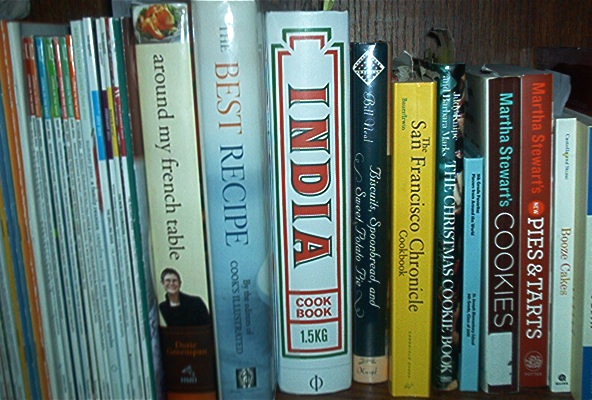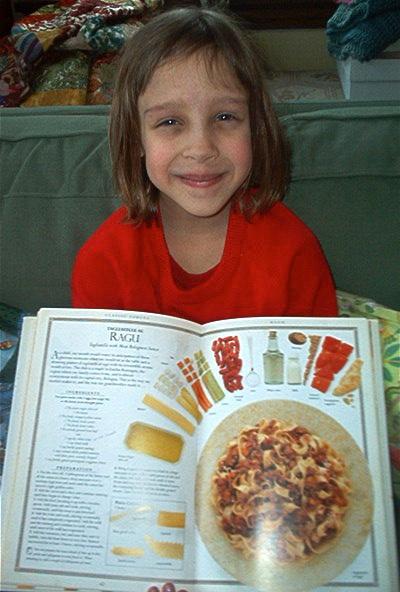The new year is beginning! How many of us are contemplating what we want to do differently in 2013? If you are the primary cook for your household, or one of the primary cooks, you may be looking for ways to cook more at home. I don’t know about you, but while I am the primary cook, cooking is not primarily what I do – I have to fit in all my other roles (mother, wife, daughter, friend, worker, etc.) during the day, too. One tool that can make it easier to cook at home is knowing ahead of time what you are cooking. Planning out the meals for the week definitely helps me when 5:30 rolls around and the family starts milling around looking hungry.
Until my daughter came along six years ago, meal planning was a theoretical pursuit for me at best. I might have an idea for two or three meals I wanted to make each week, and then would fill in other nights with whatever looked good at the grocery store. Or whatever kind of take-out I passed on my way home. Or whatever could be cobbled together from the fridge and pantry. Sometimes cooking this way was fun, sometimes it was frustrating. But it always involved extra trips to the store (and extra groceries, because who only buys what is on the list?).
 Once life
became more complicated with juggling a baby and her quirky schedule, figuring
out what to eat suddenly became a source of stress and aggravation. So I began
planning out each week’s meals. That way, I only had to come up with ideas once
and (hopefully) only make one shopping trip. I started just jotting down lists
of main dishes. Eventually I moved from using scrap paper to making up an Excel
template with space on the front for menus and space on the back for the shopping
list. The Excel template worked well, but still, I was always on the lookout
for another good addition to my menu planning toolbox.
Once life
became more complicated with juggling a baby and her quirky schedule, figuring
out what to eat suddenly became a source of stress and aggravation. So I began
planning out each week’s meals. That way, I only had to come up with ideas once
and (hopefully) only make one shopping trip. I started just jotting down lists
of main dishes. Eventually I moved from using scrap paper to making up an Excel
template with space on the front for menus and space on the back for the shopping
list. The Excel template worked well, but still, I was always on the lookout
for another good addition to my menu planning toolbox.
A few months ago a friend invited me to join a Facebook group whose members share their weekly menu plans. It is a vibrant, helpful, recipe-sharing community that encompasses families of all sizes, from omnivores to vegetarians, the gluten-free to the fish-free. People who have extras from their gardens might offer them to the group (which is how I ended up with a couple excellent pie pumpkins this fall), or members might share knowledge about buying fresh eggs from local farmers. Some members of the group love to cook, other members only cook because people need to eat. In general, we are all home cooks who want to prepare healthy meals, who often have a budget to keep in mind, and who sometimes struggle with finicky eaters (it isn’t just kids!) or divergent appetites within one family.
An informal poll of my fellow Grand Forks menu planners revealed some similar reasons for doing what we do: budget planning and saving, one grocery store trip a week (or every two weeks!), less worry about what to make at the end of each day, and meals that are healthier. Often what someone posts will lead to a discussion of a particular recipe and possible variations, or inspire another cook to try the same recipe. One friend’s family loves Rick Bayless’s Cowboy Beans, and seeing that dish show up periodically on her menu reminded me that it had been a while since I had made our favorite Bayless recipe: Tacos with Potatoes and Poblanos. The menus from the vegetarian members help me remember that I want to work more veggie or grain-based meals into our week, and give me ideas for what vegetarian dishes my family might like.
 It is also
comforting to know that similar things can derail the best-laid plans of other
primary cooks, too. Just as having spouses and kids join in the planning can
make it easier and more fun, their resistance or non-participation can be a
deal-breaker. If you are the only one coming up with all the ideas every week,
something that could be an adventure quickly becomes a dreaded chore. Ditching
the plan for a restaurant meal – a meal someone else prepares, serves, and
cleans up – can be tempting at the end of a long day. (I already have a pan of
cheese enchiladas ready to go into the oven this evening, and just typing that
sentence still makes going out sound very tempting!)
It is also
comforting to know that similar things can derail the best-laid plans of other
primary cooks, too. Just as having spouses and kids join in the planning can
make it easier and more fun, their resistance or non-participation can be a
deal-breaker. If you are the only one coming up with all the ideas every week,
something that could be an adventure quickly becomes a dreaded chore. Ditching
the plan for a restaurant meal – a meal someone else prepares, serves, and
cleans up – can be tempting at the end of a long day. (I already have a pan of
cheese enchiladas ready to go into the oven this evening, and just typing that
sentence still makes going out sound very tempting!)
One way to combat these obstacles is to get everyone in on the planning – even though that is seldom as easy as it sounds. Cookbooks with pictures help, as do magazines. Keep a list of favorites handy for those spaces on the plan where you have no idea what to do next. At our house, I know that when I’m feeling uninspired I can write in stacked cheese enchiladas, chicken noodle soup, pizza, pigs in blankets, or ham & pea pasta – meals that are quick, easy, and sure to please. Most meals in our house come accompanied by a green salad and we mostly bake our own bread using the Artisan Bread in 5 Minutes a Day method. Because of these two things, I know that lettuce and flour will almost always be on our shopping list. The produce we find in the store up in Grand Forks – and its quality/condition – often feels a little random, so we will simply write “green vegetable” on the menu plan and once we get to the store we’ll find out if that means zucchini, Brussels sprouts, green beans, or spinach.
Being part of the menu planning group has also given me a peek into my friends’ kitchens. I know who to talk to when I want to find a new grain, who might be able to offer advice about where to find exotic ingredients in town, and who also has a child or two with a selective palate. If you have a circle of friends and acquaintances who like to cook – or who you know are trying to cook more at home – start a What’s for Dinner? Group for your own neighborhood!
Some suggestions to help get in the habit of menu planning:
- Pick a night to plan – ideally not the same day you plan to do your shopping. Give yourself at least a chance to sleep on the plan, and to remember the things you forgot to put on the list! Plus, this helps keep your tasks/day ratio comfortable.
- Know the household schedule for the week (Which night is gymnastics? Who has choir rehearsal which night? Is it Family Movie Night on Friday?).
- If the chances are slim that other household members will be around when you are planning, start a list of favorites or a meal “wish list” and get them to add to it during the week (how often do you hear a friend or coworker talking about a delicious meal and decide you want to have that, too?). This way the entire burden of meal planning isn’t on one person’s shoulders.
 Get out your favorite cookbooks or recent cooking magazines.
Ones with pictures are especially good if a kid is helping you choose dishes.
One of my 2013 cooking goals is to make at least one dish from each cooking
magazine that crosses the threshold.
Get out your favorite cookbooks or recent cooking magazines.
Ones with pictures are especially good if a kid is helping you choose dishes.
One of my 2013 cooking goals is to make at least one dish from each cooking
magazine that crosses the threshold.
- Find a planning format that works for you – there are apps for this, after all! Or maybe you prefer writing it out. It doesn’t really matter, as long as it works for you.
- Don’t feel bad if you go off your plan from time to time. Sometimes the day takes an unexpected turn. You can choose whether to bump all the meals down a day, or just the one. Or maybe the unused ingredients can be absorbed into another meal. Or go ahead and cook it, then pack it up for lunches.
- For the past couple years my primary New Year’s Resolution has been to cook, on average, one new recipe a week. It might be a main dish, a side, a breakfast, or a baked good. For the first week of the new year I had a (delicious) Greek soup from the Bean by Bean cookbook on the menu!
 Merie Kirby grew
up in California, moved to Minneapolis for grad school, and after
getting her MFA stayed for fifteen more years. She now lives in Grand
Forks, ND with her husband and daughter. Merie writes poetry and essays,
as well as texts in collaboration with composers. She also writes about
cooking, reading, parenting, and creating on her own blog, All Cheese Dinner. Her most recurrent dream is of making cookies with her mother. This is an excellent dream. Her last artilce for SGT was: Meatless Mondays (or Wednesdays or Saturdays).
Merie Kirby grew
up in California, moved to Minneapolis for grad school, and after
getting her MFA stayed for fifteen more years. She now lives in Grand
Forks, ND with her husband and daughter. Merie writes poetry and essays,
as well as texts in collaboration with composers. She also writes about
cooking, reading, parenting, and creating on her own blog, All Cheese Dinner. Her most recurrent dream is of making cookies with her mother. This is an excellent dream. Her last artilce for SGT was: Meatless Mondays (or Wednesdays or Saturdays).

